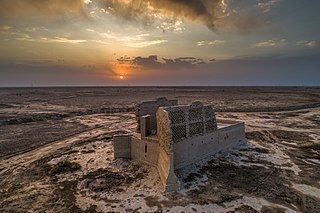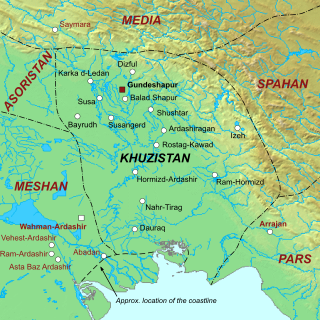
Bahram I was the fourth Sasanian King of Kings of Iran from 271 to 274. He was the eldest son of Shapur I and succeeded his brother Hormizd I, who had reigned for a year.

Bahram IV, was the Sasanian King of Kings of Iran from 388 to 399. He was likely the son and successor of Shapur III.

Shapur I was the second Sasanian King of Kings of Iran. The precise dating of his reign is disputed, but it is generally agreed that he ruled from 240 to 270, with his father Ardashir I as co-regent until the death of the latter in 242. During his co-regency, he helped his father with the conquest and destruction of the city of Hatra, whose fall was facilitated, according to Islamic tradition, by the actions of his future wife al-Nadirah. Shapur also consolidated and expanded the empire of Ardashir I, waged war against the Roman Empire, and seized its cities of Nisibis and Carrhae while he was advancing as far as Roman Syria. Although he was defeated at the Battle of Resaena in 243 by Roman emperor Gordian III, he was the following year able to win the Battle of Misiche and force the new Roman emperor Philip the Arab to sign a favorable peace treaty that was regarded by the Romans as "a most shameful treaty".

Ardashir I, also known as Ardashir the Unifier, was the founder of the Persian Sasanian Empire. He was also Ardashir V of the Kings of Persis, until he founded the new empire. After defeating the last Parthian shahanshah Artabanus IV on the Hormozdgan plain in 224, he overthrew the Arsacid dynasty and established the Sasanian dynasty. Afterwards, Ardashir called himself "shahanshah" and began conquering the land that he called Iran.

Margiana is a historical region centred on the oasis of Merv and was a minor satrapy within the Achaemenid satrapy of Bactria, and a province within its successors, the Seleucid, Parthian and Sasanian empires.

Sakastan was a Sasanian province in Late Antiquity, that lay within the kust of Nemroz. The province bordered Kirman in the west, Spahan in the north west, Kushanshahr in the north east, and Turan in the south east. The governor of the province held the title of marzban. The governor also held the title of "Sakanshah" until the title was abolished in ca. 459/60.
Sasan, considered the eponymous ancestor of the Sasanian Dynasty in Persia, was "a great warrior and hunter" and a Zoroastrian high priest in Pars. He lived sometime near the fall of the Arsacid (Parthian) Empire in the early 3rd century.

Mazun was a Sasanian province in Late Antiquity, which corresponded to modern-day Bahrain, Qatar, United Arab Emirates, and the northern half of Oman. The province served as a Sasanian outpost and played an important role in the Sasanian efforts to gain control over the Indian Ocean trade, and to establish their dominance in the wealthy regions of Hadramaut and Yemen.

The Sasanian Empire or Sassanid Empire, also known as the Second Persian Empire, and officially known as Ērānšahr, was the last Iranian empire before the early Muslim conquests of the 7th to 8th centuries. Named after the House of Sasan, it endured for over four centuries, from 224 to 651, making it the second longest-lived Persian imperial dynasty after the Arsacids of the Parthian Empire.

Pabag was an Iranian prince who ruled Istakhr, the capital of Pars, from 205 or 206 until his death sometime between 207 and 210. He was the father, stepfather, grandfather, or father-in-law of Ardashir I, the founder of the Sasanian Empire. He was succeeded by his eldest son, Shapur.

Sistān, also known as Sakastān and Sijistan, is a historical region in present-day south-eastern Iran, south-western Afghanistan and extending across the borders of south-western Pakistan. Mostly corresponding to the then Achaemenid region of Drangiana and extending southwards of the Helmand River not far off from the city of Alexandria in Arachosia. Largely desert, the region is bisected by the Helmand River, the largest river in Afghanistan, which empties into the Hamun Lake that forms part of the border between Iran and Afghanistan.
Amazasp III or Hamazasp I was a king (mepe) of Iberia from 260 to 265 AD. According to Cyril Toumanoff he may have been a scion of the Pharnavazid dynasty, while Richard N. Frye states that he was an Iranian, possibly related to the royal Sasanian family.

Padishkhwārgar was a Sasanian province in Late Antiquity, which almost corresponded to the present-day provinces of Mazandaran and Gilan. The province bordered Adurbadagan and Balasagan in the west, Gurgan in the east, and Spahan in south. The main cities of the province were Amol and Chalus.

Spahan, also known as Parthau was a Sasanian province in Late Antiquity, that lay within central Iran, almost corresponding to the present-day Isfahan Province in Iran.

Turan was a province of the Sasanian Empire located in present-day Pakistan. The province was mainly populated by Indo-Aryans, and bordered Paradan in the west, Hind in the east, Sakastan in the north, and Makuran in the south. The main city and bastion of the province was Bauterna (Khuzdar/Quzdar).

Shapur was an Iranian prince, who was the penultimate King of Persis from 207–210 to 211/2. He was succeeded by his younger brother Ardashir I, who founded the Sasanian Empire.

The Kings of Persis, also known as the Darayanids, were a series of Persian kings, who ruled the region of Persis in southwestern Iran, from the 2nd century BCE to 224 CE. They ruled as vassal kings of the Parthian Empire, until they toppled them and established the Sasanian Empire. They effectively formed some Persian dynastic continuity between the Achaemenid Empire and the Sasanian Empire.
The Temple of Anahita was an ancient fire temple in Istakhr dedicated to the worship of the Iranian goddess Anahid.

Khuzistan or Huzistan was a Sasanian province in Late Antiquity, which almost corresponded to the present-day province of Khuzestan. Its capital was Gundeshapur. During the late Sasanian era, the province was included in the southern quadrant (kust) of Nemroz.

![]() ) was a Sasanian prince, who ruled Marv from ca. 240 to 262. He was either a brother or son of the Sasanian king Ardashir I (r. 224-242), who had installed him as the ruler of Marv, which was the outpost of his empire in the north-east.
) was a Sasanian prince, who ruled Marv from ca. 240 to 262. He was either a brother or son of the Sasanian king Ardashir I (r. 224-242), who had installed him as the ruler of Marv, which was the outpost of his empire in the north-east.













